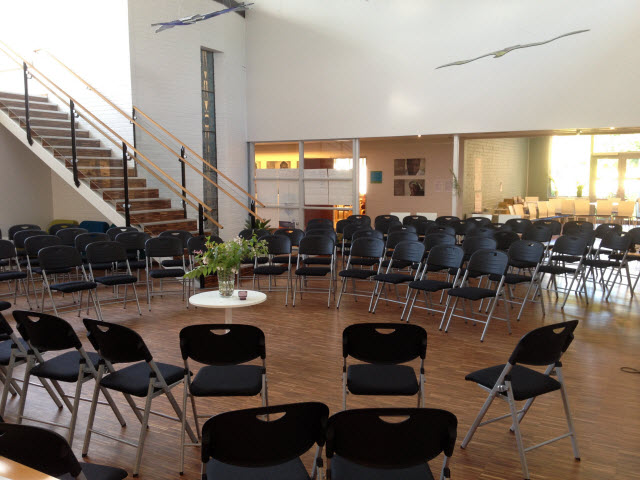Introduction
The purpose of this post is to share some of my experiences from the Nordic Friends Yearly Meeting (June 29—July 2), which was held at Nordiska Folkhögskolan, Kungälv, Sweden.
Background
I’m very interested in the Quakers method of making collective decisions and have written about it here and here (in Swedish).
Here is my review (in English) of Michael J. Sheeran’s book Beyond Majority Rule: voteless decisions in the Religious Society of Friends. Sheeran spent two years (1973—75) conducting interviews, reading, and observing the actual decision-making of the Friends. He is convinced that the Quakers have something of first importance to share in their method.2 I am so too!
Here is also my review (in English) of A Quaker Approach to the Conduct of Research: Collaborative Practice and Communal Discernment, which has grown out of a decade of experiments employing Quaker processes of communal discernment in research.1 The book itself is an example of collaborative work.

Program
The Nordic Friends Yearly Meeting started and ended with meetings for (silent) worship and decision-making. The clerks3 from the Nordic countries welcomed all participants at the start, and functionaries for the Yearly Meeting were elected. The epistle4 was reviewed and approved at the end of the Yearly Meeting. Each Nordic country had, in addition, their own decision-making meetings. I participated in the meeting of the Swedish Friends.
Theme
The theme for the Yearly Meeting was “Am I my brother’s keeper?” The theme was explored in a talk by a Finnish Friend (in no less than four languages). Her conclusion was that Cain and Abel, in the biblical Book of Genesis, represent two sides of each human being, and each society, in patterns of active and passive violence. Several workshops were held on the theme.
Observations
Participating in the Yearly Meeting was an experience on many levels. My focus here is on the decision-making. The primary reason why I wanted to participate was to observe the actual decision-making, but sitting in silence together with others during long time influences you more than you might think.
Initially, I viewed myself as an observer, but I realized after a while that it was an impossible role. A Swedish Friend expressed it as “a Friend of Friends is a Friend.” And a Friend from Great Britain told me that you are a participant in the decision-making meeting simply by being present. Interestingly, he had experiences of making decisions in meetings with a thousand participants.
Two clerks guided the decision-making meeting of the Swedish Friends. The clerks passed a candle between themselves to show the meeting who was the active clerk. The clerk kept the meeting in silence by looking down, and invited people to speak by looking up. Participants who talked stood up. The point is that only one person can stand up at a time. The minute of each item was prepared before moving on to the next item.
One of the agenda items had to do with the approval of new members. I was sent out together with other non-members during that item. I was later told that the meeting had become particularly interesting at that time and that the clerk had handled it really well. Unfortunately, I never got the opportunity to see it myself.
It was decided at the final meeting that the next Nordic Friends Yearly Meeting will be held in 2020. As already mentioned, the meeting epistle was also reviewed and approved. I got the impression that the presiding clerks were relieved that it went so smoothly. The meeting ended thirty minutes ahead of time.
Conclusions
The key takeaway for me is that the Quakers show that it’s possible to make collective decisions. A prerequisite, though, is the following: “We act as a community, whose members love and trust each other. […] As a […] community, […] we have a continuing responsibility to nurture the soil in which unity may be found.”4
The theme which was explored is, in my view, related to the sharing of decision-making power (or lack thereof). The desire to have power over people, to force our view on them, leads to violence. The places to begin applying the skills and generosity to avoid violence and to resolve conflicts are in our personal relationships, our workplaces, and wherever decisions are made.
Notes:
1 Gray Cox et al., A Quaker Approach to the Conduct of Research: Collaborative Practice and Communal Discernment (Quaker Institute for the Future, 2014), p. ix.
2 Michael J. Sheeran, Beyond Majority Rule: voteless decisions in the Religious Society of Friends, p. ix.
3 The clerk (ombud in Swedish) guides the meeting. The clerk has to discern the ‘the sense of the meeting’ of each item and prepare a minute. The final decision about whether the minute represents the sense of the meeting is the responsibility of the meeting itself, not of the clerk. See Clerks – Quakers in Britain (accessed 2017-07-03).
4 The epistle (epistel in Swedish) is a letter sent by the Yearly Meeting to all other Yearly Meetings. See Epistle (Quaker) – Wikipedia (accessed 2017-07-03).
5 Britain Yearly Meeting, Quaker faith & practice (5th Edition, 2013), Chapter 3.02.
Leave a Reply
You must be logged in to post a comment.